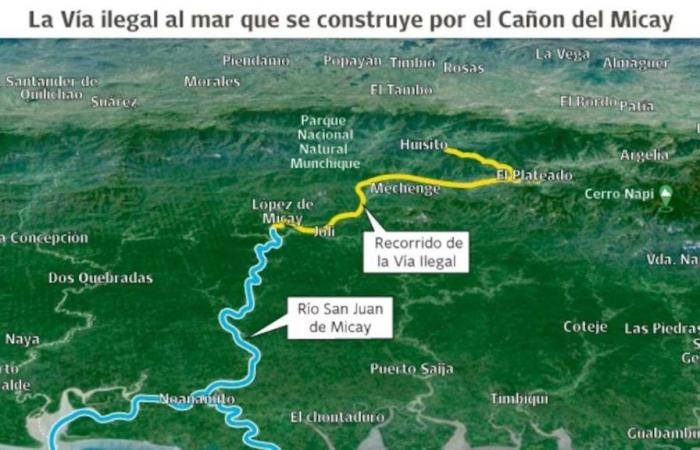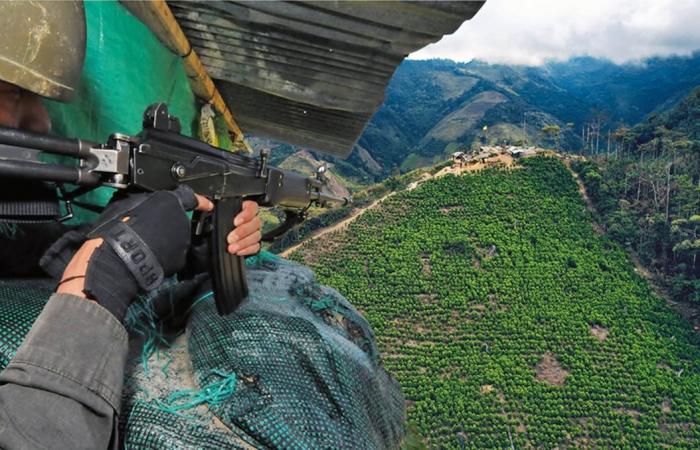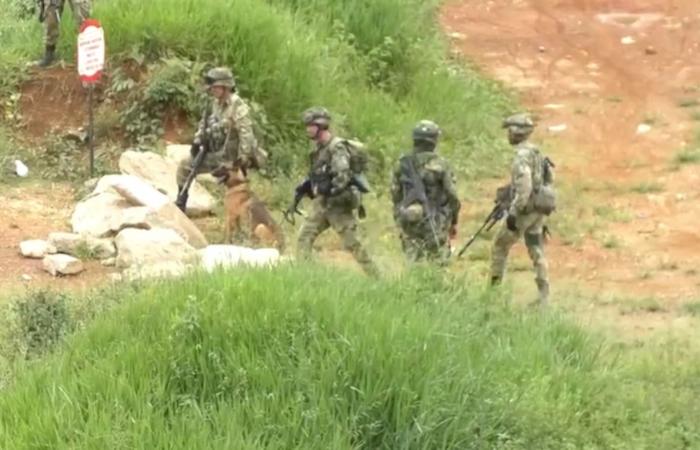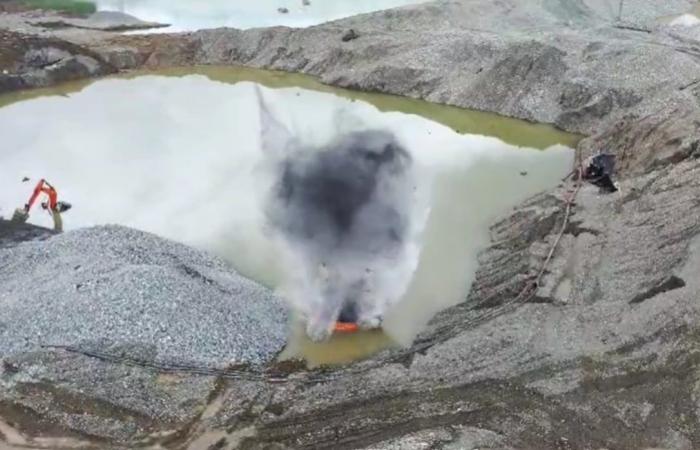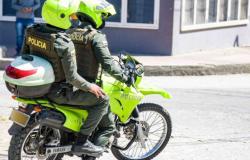This route not only facilitates the trafficking of drugs and chemical precursors, but also imposes a tax of $1,500 per arroba of coca leaf produced, reveals an exclusive investigation by El País.
The highway, which has been under the control of armed groups, leaves Huisitó to El Plateado and then connects to the municipality of López de Micay to continue across the river towards the Pacific Ocean.
This road, whose construction began in 2017 without technical or environmental studies and without any type of permit, starts from the town of Huisitó, in the municipality of El Tambo, and continues throughout the river canyon to the municipality of López de Micay, through the town of El Plateado, bastion of ‘Iván Mordisco’ dissidence and scene of the greatest conflict being waged today in Colombia.
Iván Mordisco’s dissidents are the ones that are present and exercise control in the Micay canyon. | Photo: Long Visual Press/Universal Imag
Although at the time the former governor Elías Larrahondo and the former mayor of El Tambo himself, Carlos Alberto Vela, denounced before the Public Force and the National Government that this ‘ghost’ work would be favoring drug trafficking and illegal mining, the complexity of public order in The area did not allow the State to take any action to prevent it.
Today, through social networks such as Instagram and TikTok, a wide road can be seen, on land, between the wounded mountain and immense coca leaf crops, the main product of the area and what was the largest source of financing. of this road, where motorcycles and vehicles travel, including a public transport route.
And although it is clear to the National Government that this highway is illegal, despite the fact that it connects in sections with legal roads of the national, departmental or local order, some sectors of the community assured El País that the road is community and was made with resources of the same citizens and the need to communicate with other towns and municipalities.
The illegal route makes its way through the mountains and through extensive coca leaf crops. | Photo: Juan Carlos Sierra
“The road we built that connects Huisitó below the road to the sea is a community road. From Huisitó to Honduras it was a 29 kilometer stretch (…) and the stretch that connected Honduras with San Juan and El Plateado was another variant made by the community on the other side,” explains Ana Jolby Pérez, who was a member of the Community Action Board of the Huisitó district at the time when the works began.
About to reach the Pacific
Satellite maps allow us to see that the road (See central image) leaves from Huisitó to El Plateado and then connects towards the Pacific Ocean with sectors such as San Juan, Honduras, Betania, Aguas Claras and Nayita, to end near the municipality of López de Micay .
“What I understand is that the road reaches Aguas Claritas and that to continue towards the municipality of López you have to continue by motor, along the river,” indicates the former community leader.

The Micay canyon is the largest scene of the armed conflict that is being waged today in Colombia. | Photo: JORGE OROZCO / Military Forces
However, sources in the municipality of Argelia, to which the town of El Plateado corresponds, indicated that the route most favored is armed groups for the drug trafficking business and the movement of chemical precursors.
“For that road, the coca growers, those who had their farm, had to pay $1,500 pesos for each arroba of coca leaf produced; The town’s merchants were forced to allocate a contribution according to the type and size of business they had; The homeowners were also required to make a contribution to open that road and a public transportation company, Transtambo, also made a contribution.”assures the source under reservation of his identity.
The value per kilometer, according to information given to El País, was $52 million, not including the construction of bridges or sewer works. That price was only for machinery operators and explosives workers who destroyed rock where necessary.
“There the only guarantee there was was that of the ELN, which also made a financial contribution, and that of the dissidents when they took control. But the route was imposed because even the main role of the armed groups was to pressure and threaten people who did not want to pay the fee they were forced to pay.said the source.

Members of the Military Forces have remained in recent months trying to close illegal financing to armed groups. | Photo: Army
Among the regulations imposed by the armed groups were also some demands on the machinery contractors and their workers, who not only had to have a special permit to enter that area of the Micay canyon, but were also prohibited from taking photographs.
In this regard, community leader Ana Jolby Pérez insisted that “It was a 100% community road that also had branch roads to the paths that at that time were cut off by road.”
“At first it was difficult to get the road into people’s hearts, among other things because everyone wanted it to pass by their house, but as soon as it passed through their path and they saw the benefits, more people joined the cause and helped. to convince others who were reluctant to contribute to a work that ended up benefiting everyone,” explains Ana Jolby.

The uniformed men against illegal mining arrived at the criminals’ fort, in a rural area of the municipality of López de Micay. | Photo: Police
The former mayor of El Tambo Carlos Alberto Vela, assured that The road is not the one planned to connect Popayán and Pacífico through a port similar to Buenaventura. “This is a road without technical engineering standards, with many forced curves, difficult to access and where no vehicle can travel if it is not a 4×4, but it has facilitated communication in the Micay canyon.”
“The road to the sea was made phase 1 and phase 2 was contracted, but due to public order it was not continued. It went from Popayán to El Tambo and then to El Plateado to leave for Guapi, which is where there is a deep bay,” recalled Vela, who was also Secretary of Works at El Tambo between 1996 and 2003.
The dream of the road to the sea for Cauca remains postponed because the Micay canyon is a place where the State does not exercise authority. Even the Public Force has been detained and removed on several occasions and the Ombudsman’s Office has had to mediate to get the community to release them.

